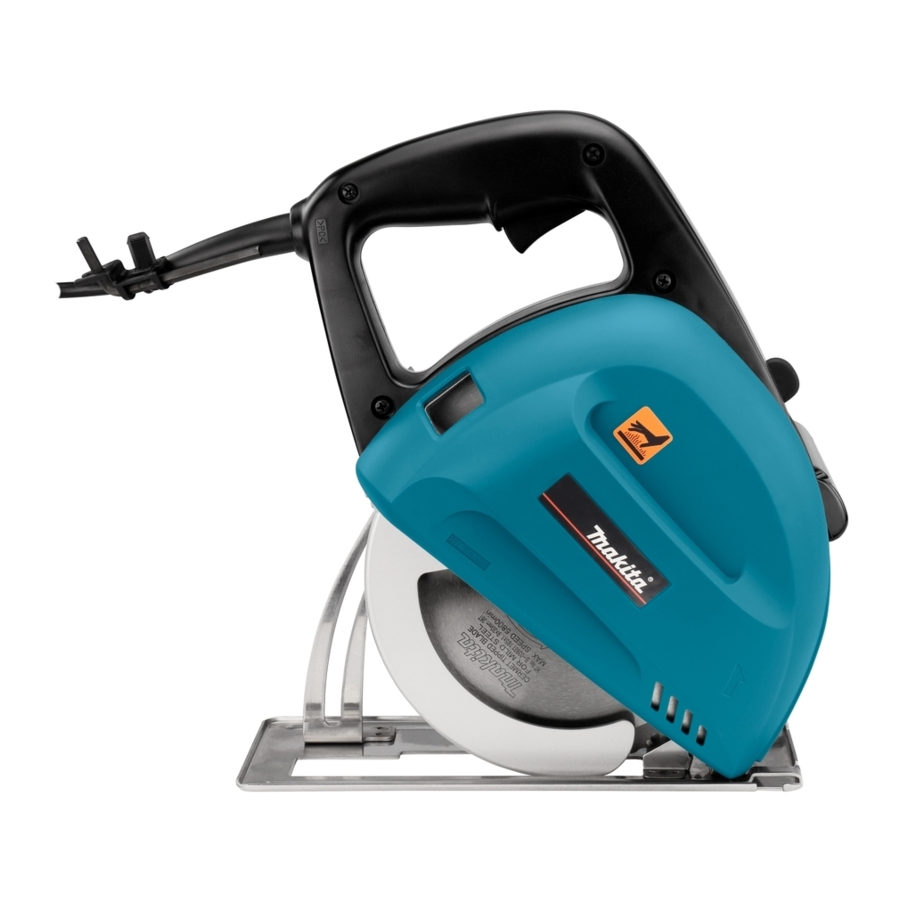Makita 4131 Instrukcja obsługi - Strona 5
Przeglądaj online lub pobierz pdf Instrukcja obsługi dla Elektronarzędzie Makita 4131. Makita 4131 12 stron. Metal cutter
Również dla Makita 4131: Instrukcja obsługi (12 strony), Instrukcja obsługi (14 strony), Instrukcja obsługi (12 strony), Instrukcja obsługi (12 strony)

When restarting a tool in the workpiece,
•
center the blade in the kerf and check that
blade teeth are not engaged into the
material. If blade is binding, it may walk up
or kickback from the workpiece as the tool is
restarted.
Support large panels to minimise the risk
•
of blade pinching and kickback. Large
panels tend to sag under their own weight.
Supports must be placed under the panel on
both sides, near the line of cut and near the
edge of the panel.
Do not use dull or damaged blades.
•
Unsharpened
produce narrow kerf causing excessive friction,
blade binding and kickback.
Blade depth and bevel adjusting locking
•
levers must be tight and secure before
making cut. If blade adjustment shifts while
cutting, it may cause binding and kickback.
Use extra caution when making a "plunge
•
cut" into existing walls or other blind areas.
The protruding blade may cut objects that can
cause kickback. For plunge cuts, retract lower
guard using retracting handle.
10. Check lower guard for proper closing before
each use. Do not operate the tool if lower
guard does not move freely and close instantly.
Never clamp or tie the lower guard into the
open position. If tool is accidentally dropped,
lower guard may be bent. Raise the lower guard
with the retracting lever and make sure it moves
freely and does not touch the blade or any other
part, in all angles and depths of cut.
To check lower guard, open lower guard by hand,
then release and watch guard closure. Also check
to see that retracting handle does not touch tool
housing. Leaving blade exposed is VERY
DANGEROUS and can lead to serious personal
injury.
11.
Check the operation and condition of the lower
guard spring. If the guard and the spring are
not operating properly, they must be serviced
before use. Lower guard may operate sluggishly
due to damaged parts, gummy deposits, or a
buildup of debris.
12. Lower guard should be retracted manually
only for special cuts such as "plunge cuts"
and "compound cuts." Raise lower guard by
retracting handle and as soon as blade enters
the material, the lower guard must be released.
For all other sawing, the lower guard should
operate automatically.
or
improperly
set
13. Always observe that the lower guard is
covering the blade before placing tool down
on bench or floor. An unprotected, coasting
blade will cause the tool to walk backwards,
cutting whatever is in its path. Be aware of the
time it takes for the blade to stop after switch is
released.
14. Do not stop the blades by lateral pressure on
the blade.
15. DANGER:
Do not attempt to remove cut material when
blade is moving.
CAUTION: Blades coast after turn off.
blades
16. Place the wider portion of the tool base on that
part of the workpiece which is solidly
supported, not on the section that will fall off
when the cut is made.
17. Never attempt to make a cut with the tool held
upside down in a vise. This is extremely
dangerous and can lead to serious accidents.
18. Wear safety goggles and hearing protection
during operation.
19. Always use blades recommended in this
manual. Do not use any abrasive wheels.
SAVE THESE INSTRUCTIONS.
WARNING:
DO NOT let comfort or familiarity with product
(gained from repeated use) replace strict adherence
to safety rules for the subject product. MISUSE or
failure to follow the safety rules stated in this
instruction manual may cause serious personal
injury.
FUNCTIONAL DESCRIPTION
CAUTION:
Always be sure that the tool is switched off and
•
unplugged before adjusting or checking function on
the tool.
Adjusting the depth of cut
1
2
005344
5
1. Lever
2. Depth guide
